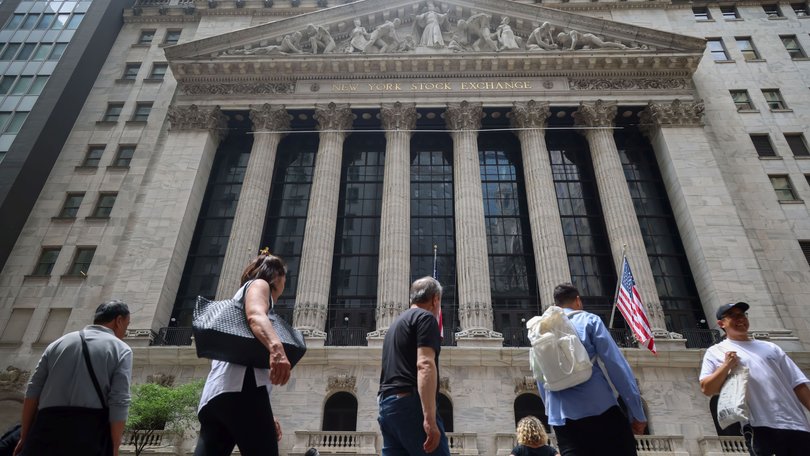THE WASHINGTON POST: Wall Street sets a new record. Here’s what drove the US stock market from dip to rip

The US stock market ended the first half of 2025 with back-to-back record highs, defying a rollicking few months of trade tensions and economic uncertainty that sent it deep into negative terrain in April.
The S&P 500, the widely followed index that underpins the retirement accounts of millions of Americans, sank into a deep correction after President Donald Trump announced sweeping tariffs, rattling financial markets in March and April.
But momentum shifted over the next several weeks as the White House backed off its steepest tariffs. On Monday, the benchmark index closed at 6204.95, up 0.5 per cent, building on its record finish from Friday. It’s now up 5.5 per cent for the year.
Sign up to The Nightly's newsletters.
Get the first look at the digital newspaper, curated daily stories and breaking headlines delivered to your inbox.
By continuing you agree to our Terms and Privacy Policy.The tech-heavy Nasdaq composite index also ended 0.5 per cent higher, to settle at 20,369.73, for its second consecutive record finish. It has gained 5.5 per cent for the year. The Dow Jones Industrial Average climbed 0.6 per cent, to 44,094.77, and has now advanced 3.6 per cent year to date.
The recent highs — coming about 90 days after the previous record in February — mark “one of the quickest recoveries that we’ve seen in recent times,” said Larry Adam, chief investment officer at Raymond James.
Corporate spending on artificial intelligence continued to drive an outsize share of the gains, as companies in software and energy surged relative to the broader market.
The market performance also reflects the fact that the economy hasn’t slipped into a recession as many experts feared; corporate earnings remain strong, and the labour market has shown resilience, with joblessness near longtime lows.
Nor has inflation run out of control: Prices rose 2.3 per cent in May compared with a year ago, as Americans reduced spending for the first time since January, according to recently released federal figures.
Still, some analysts see reason to be cautious. Consumer sentiment increased in June but is still down from December, according to the latest University of Michigan survey.
The US economy contracted more than previously estimated in the first quarter, according to revised GDP figures last week from the Commerce Department’s Bureau of Economic Analysis, as consumers reined in spending. The US dollar’s value has slid to a three-year low, hurting Americans’ purchasing power.

“We’re definitely seeing some trade down from higher-priced retailers, convenience stores, supermarkets, drugstores,” Loop Capital Markets senior equity analyst Anthony Chukumba said, commenting on Dollar General, which saw its stock price increase more than 50 per cent year to date.
Dollar General probably also benefited from its low exposure to China and from competitors, such as Big Lots, closing stores or going out of business, he added.
The US consumer may not be spending like a “sailor . . . on shore leave” as they do in good times, but they haven’t stopped spending, said John Stoltzfus, Oppenheimer’s chief investment strategist.
“The consumer, when concerned about the economy as it pertains to employment prospects or the cost of money reflected in interest rates, tends to gravitate towards private label goods, discount stores and used cars,” he said.
Tech companies helped drive market gains. Shares of AI chipmaker and semiconductor companies Nvidia and Broadcom surged more than 17 per cent and 19 per cent, respectively, in the first six months of the year, while Intel grew 12 per cent. Nvidia’s growth is particularly noteworthy because the S&P 500 is weighted, meaning big companies such as Apple, Nvidia and Microsoft have outsize sway on its overall performance.
The AI boom also extended to certain utilities and energy equipment stocks — which are expected to benefit from AI data centres’ electricity needs. NRG Energy soared more than 79 per cent, while the gas-powered turbine manufacturer and service provider GE Vernova jumped about 60 per cent.
“We’re suddenly seeing this incredible inflection in the amount of new power generation that the grid needs,” said Austin Wang, a senior equity analyst at GLJ Research covering electrification industrials and infrastructure.
“And while part of this is definitely a function of data centre demand, it is not just AI but also organic,” as operators swap out or service aging fleets, among other factors.
The market rebounds came despite early-year concerns that AI and retail companies would tank amid competition from China and broader belt-tightening due to tariffs and high inflation.
Tech stocks tumbled at the start of 2025, after DeepSeek an AI chatbot released by a Chinese start-up — rocketed to the top spot in Apple’s app store, stoking fears that US companies were overspending on AI infrastructure that would not become profitable.
DeepSeek initially “seemed to work awfully well — it worked much more cheaply and required less hardware to operate,” said longtime stock analyst Ed Yardeni. But some of the hype around DeepSeek fell away, and US-based tech companies continued to spend heavily on the sector, according to corporate earnings reports.
“Tech companies have continued to invest. In fact, they are expected to actually increase their spending not only this year but into next year,” said Mr Adam, of Raymond James.
The tech sector may have “started the year with its back against the wall,” but “the mojo is back,” Wedbush Securities senior analyst Dan Ives said.
Other tech companies outperformed the broader market.
Shares of Palantir Technologies — a data integration and AI company with many government contracts — swelled more than 80 per cent. Palantir recently said it would help develop software with a nuclear energy project development firm, as many countries are showing more appetite for the energy source, said Mark Giarelli, equity analyst for Morningstar. And the company separately said it would partner with Accenture Federal Services “to help federal government agencies reinvent operations with AI”.
Cryptocurrency exchange Coinbase Global grew more than 40 per cent, much of that after Congress began advancing legislation that would add regulations around stablecoins, a kind of cryptocurrency value that is tied to another asset such as the dollar.
“This has been a transformational year for Coinbase, both in terms of its own platform and the environment in which the company operates,” including a more crypto-friendly regulatory approach in the United States than in past administrations, said Mark Palmer, equity research analyst at the Benchmark Co.
Still, not every tech stock did well — a break from past years when a group of “Magnificent 7” tech stocks consistently outperformed the markets.
Alphabet — the parent company of Google, which has faced pressure from AI search tools such as ChatGPT — Apple and Tesla all ended the first half of the year down. Some Apple products could be affected by tariffs, and the company’s AI efforts have faced setbacks.
Large-cap companies with insulated or flexible supply chains, or with enough capital to withstand the volatility of changing tariff policies, have also performed well, analysts said.
Underperformers include automobiles, auto parts and consumer apparel with Asian manufacturing hubs — sectors affected by tariffs that tend to be lower margin to begin with, Mr Adam said. Lululemon Athletica has shed more than 36 per cent year to date.
The market has been buffeted by the administration’s efforts to impose tariffs and negotiate other trade deals in recent months. An April plan to levy import taxes on dozens of countries was paused for 90 days — set to expire by July 9 — as negotiations continue. Canada on Sunday said it would rescind a planned tax on large tech companies after Mr Trump threatened to suspend trade talks with Ottawa.
Other tariffs have already been imposed on specific sectors, such as steel, aluminium, auto parts and imported cars.
Analysts see significant uncertainty for the second half of the year.
Sam Stovall, chief investment strategist at CFRA, said both 2023 and 2024 ended in bull markets — and few two-year bull markets turn into three-year runs.
“The Kansas City Chiefs will be the first to tell you that three-peats are very hard to accomplish,” he said.
(c) 2025 , The Washington Post
Originally published as Stocks set new record to wrap up first half; here’s what drove markets
